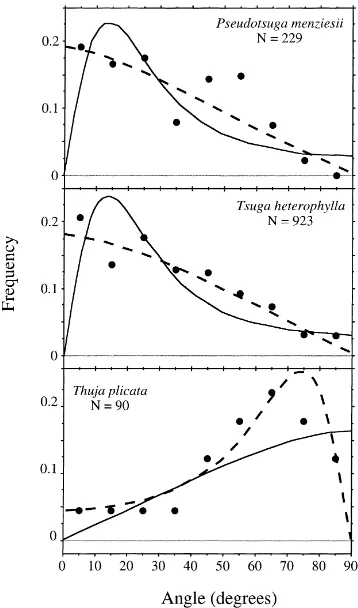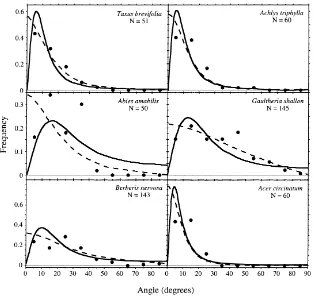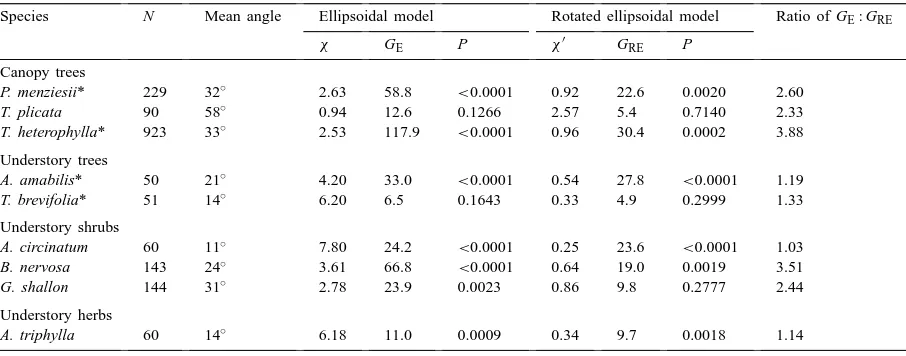A rotated ellipsoidal angle density function improves estimation of
foliage inclination distributions in forest canopies
Sean C. Thomas
∗, William E. Winner
Department of Botany and Plant Pathology, Oregon State University, Corvallis, OR 97331, USA
Received 8 February 1999; received in revised form 19 August 1999; accepted 27 August 1999
Abstract
The ‘ellipsoidal distribution’, in which angles are assumed to be distributed parallel to the surface of an oblate or prolate ellipsoid, has been widely used to describe the leaf angle distribution (LAD) of plant canopies. This ellipsoidal function is constrained to show a probability density of zero at an inclination angle of zero; however, actual LADs commonly show a peak probability density at zero, a pattern consistent with functional models of plant leaf display. A ‘rotated ellipsoidal distribution’ is described here, which geometrically corresponds to an ellipsoid in which small surface elements are rotated normal to the surface. Empirical LADs from canopy and understory species in an old-growth coniferous forest were used to compare the two models. In every case the rotated ellipsoidal function provided a better description of empirical data than did the non-rotated function, while retaining only a single parameter. The ratio of G-statistics for goodness of fit for the two functions ranged from 1.03 to 3.88. The improved fit is due to the fact that the rotated function always shows a probability density greater than zero at inclination angles of zero, can show a mode at zero, and more accurately characterizes the overall shape of empirical distributions. ©2000 Published by Elsevier Science B.V. All rights reserved.
Keywords: Ellipsoidal distribution; Forest canopies; Leaf angle distribution; Plant canopies; Radiation transmission
1. Introduction
One of the primary physical parameters impor-tant in modeling radiation transmission through plant canopies is the angular distribution of canopy ele-ments. The transmission of beam radiation through a plant canopy has commonly been described by a ‘Beer-Lambert law’ function:
Qi=Qoexp(−kLAI) (1)
∗Corresponding author. Present address: Faculty of Forestry,
University of Toronto, Toronto, Ont., Canada M5S 3B3; Tel.:
+1-416-978-1044; fax:+1-416-978-3834.
E-mail address: [email protected] (S.C. Thomas).
where Qiis the flux density below the canopy, Qothe
incoming flux density, LAI the leaf area index for the canopy, and k is the extinction coefficient (Monsi and Saeki, 1953). For a spatially random distribution of leaves, k is equal to ratio of the horizontal projection of leaf area to total leaf area. For flat canopy elements such as leaves, k thus depends entirely on the angular distribution of the elements.
Although probability distributions of leaf angles have sometimes been described using discontinuous functions (such as horizontal, vertical, or conical dis-tributions; see Ross, 1981; Campbell and Norman, 1989), real plant canopies always show a continuous range of leaf angles. The most widely-used continuous function for describing such distributions is the ‘el-lipsoidal inclination distribution’, initially described
by Campbell (1986, 1990). This function was derived as a generalization of the spherical or uniform distri-bution function (Nichiporovich, 1961; DeWit, 1965), and considers leaves as small surface elements dis-tributed on the surface of a prolate or oblate ellip-soid. A 2-parameter beta distribution has also been employed in some studies (Goel and Strebel, 1984; Kucharik et al., 1998). However, the ellipsoidal dis-tribution function has gained wide use due to the fact that it is described by only a single parameter, and is thought to provide a reasonably accurate descrip-tion of empirical angle distribudescrip-tions for actual plant canopies. The function has been incorporated in in-version methods for measuring LAI and other aspects of canopy structure based on optical measurements (Campbell and Norman, 1989; Norman and Camp-bell, 1989; Welles and Norman, 1991; Martens et al., 1993), and is also used extensively in physical opti-cal models of radiation transfer in plant canopies (e.g. Nilson and Kuusk, 1989; Kuusk, 1995).
From a functional and evolutionary perspective, one may also ask how leaves should be distributed in plant canopies (e.g. Horn, 1971, Givnish, 1984; Hirose and Werger, 1987). Although leaf angle has received rela-tively little attention from this perspective (McMillen and McClendon, 1979; Hikosaka and Hirose, 1997; King, 1997), one generalization to emerge is that hor-izontal leaf display often maximizes light interception and carbon gain of individual plants. The functional significance of horizontal foliage display in understory plants has long been recognized (Horn, 1971, Givnish, 1984); however, recent work suggests that horizon-tal foliage may also represent a functional optimum for canopy plants in many situations, due to the ef-fects of lateral shading by neighbors (Hikosaka and Hirose, 1997). These considerations lead one to expect that many plants will show leaf angle distributions in which horizontal leaves are ‘common’. In mathemat-ical terms, the g(θ) function describing the leaf angle distribution should therefore show a positive probabil-ity densprobabil-ity at zero, and should also be capable of show-ing a mode at zero. However, the commonly-used el-lipsoidal distribution function is constrained such that
g(0)=0 for all parameter values. This suggests that the ellipsoidal model may systematically underesti-mate the frequency of leaf angles near the horizontal, and may thus inaccurately describe the overall shape of leaf angle distributions.
The objectives of this paper are (1) to derive a single-parameter ‘rotated ellipsoidal distribution’ function, similar to the ellipsoidal distribution, but with g(0) > 0 for all parameter values, and capable of showing a mode at zero; and (2) to quantitatively compare the ability of the ellipsoidal model and the rotated ellipsoidal model to describe empirical foliage angle distributions. Empirical data examined describe representative canopy and understory species in an old-growth Douglas-fir — western hemlock forest in Washington state.
2. A rotated ellipsoidal distribution function
Following Campbell (1990), the angle density func-tion for leaves with surfaces displayed parallel to an ellipsoid shape is:
g(θ )= 2χ
3sinθ
3(cos2θ+χ2sin2θ )2 (2)
whereθis the angle from the horizontal, g(θ) the prob-ability distribution ofθ, andχis the ratio of the hori-zontal semiaxis length to the vertical semiaxis length of an ellipsoid . Forχ <1,
To find the angle density function for leaves with sur-faces displayed normal to the surface of the ellipsoid, (θ−p/2) is substituted forθin Eq. (2). This yields the For any value ofχ′, the rotated ellipsoidal
distri-bution is simply the mirror image of the ellipsoid distribution over the interval 0 to p/2. Thus, for θ=0, g(θ) is zero for the ellipsoidal distribution, but
In addition, for values ofχ′<1, a leaf angle of zero
is the global maximum for g′(θ). Eq. (3) thus
satis-fies the goal of obtaining a single-parameter model in which horizontal leaves have a finite probability density, and where horizontal leaves may also repre-sent the distribution mode. For the rotated ellipsoidal distribution values of χ′<1 correspond to low leaf
angles (a planophile leaf display), while values of
χ′> 1 correspond to high leaf angles (an erectophile
leaf display).
3. Sampling methods
Observations on foliage angle distributions were collected for nine species at the Wind River Canopy Crane site, located within the Thornton T. Munger Re-search Natural Area of the Gifford Pinchot National Forest (45◦49′N 121◦58′W), in southern Washington
state. Taxa examined included three dominant conif-erous canopy trees (Pseudotsuga menziesii, Tsuga
heterophylla, and Thuja plicata), two sub-canopy
trees (Taxus brevifolia and Abies amabilis), three understory shrubs (Gaultheria shallon, Berberis
ner-vosa, and Acer circinatum), and one understory herb
species (Achlys triphylla). Botanical nomenclature follows Hitchcock and Cronquist (1973).
Branchlets are commonly treated as functional fo-liage units in coniferous trees (Stenberg et al., 1995), and branchlet angle and morphological measurements were also required for estimation of LAI at the study site (S.C. Thomas and W.E. Winner, manuscript in preparation). Therefore, angle measurements were made on branchlet (internode) angles rather than leaves for all coniferous species. For tree species, the crane’s gondola was placed at representative locations in the upper and lower canopy layers of 2–3 represen-tative trees, and branchlets were randomly selected for measurement from among foliage units accessible at a given location. In the case of T. heterophylla, additional data based on exhaustive measurements made on three harvested branches were also used. For understory shrubs and herbs, foliage units were se-lected by enumerating ramets within a given area, and randomly selecting leaves within a given ramet. Five leaves/ramet were measured (except where individual ramets possessed fewer than 5 leaves, in which case all leaves were measured). In all cases measurements
of angular deviations from horizontal were made to the nearest 1◦ using a clinometer (Suunto MC-1D,
Espoo, Finland).
Eqs. (2) and (3) were fit to data using numer-ical approximations to estimate χ and χ′. For
Eq. (2), the arithmetic mean angle (a) was calcu-lated and used to estimate χ using the formula:
χ= −3+(a/9.65)−0.6061 (derived from Eq. (16) in
Campbell, 1990). For Eq. (3), the same procedure was used, but angles were first transformed asθ′=(
p/2−θ)
to estimateχ′. Empirical data were binned into 10◦
classes for comparison to predicted values; the lat-ter were generated by numerical integration of Eqs. (2) and (3), using the program Mathematica v. 2.2 (Wolfram Research). Statistical analyses employed
G-tests for goodness of fit (Sokal and Rohlf, 1981).
Both functions examined have one parameter; the quantitative values of G-statistics were therefore used to compare goodness of fit between models.
4. Results and discussion
Foliage angle distributions for canopy trees (Fig. 1) as well as sub-canopy trees, herbs, and shrubs (Fig. 2), showed relatively poor agreement with the ellipsoidal distribution model. Goodness of fit tests indicated that distributions deviated significantly from expected val-ues for seven of the nine species examined (P<0.01), including all species with sample sizes greater than 100 (Table 1). For species with relatively plagiophile leaf displays (χ′<1), the ellipsoidal distribution
pre-dicted a pronounced local maximum at leaf angles of 5–20◦; however, there was no indication that such
a peak was actually present for any species. The
Fig. 2. Leaf angle density functions for sub-canopy and understory species sampled in an old-growth Douglas-fir — western Hemlock forest. The solid line corresponds to the fitted ellipsoidal angle density function, and the dotted line to the rotated ellipsoidal angle density function.
ellipsoidal distribution also tended to systematically underestimate the frequency of foliage angles near 50–70◦ in canopy tree species, and near 20–40◦ in
several understory species.
Empirical foliage inclination distributions were better approximated by the rotated ellipsoidal model (Figs. 1 and 2). Observed angle distributions appeared to approach a finite value at small inclination angles in all cases, as assumed by the model. Although, sta-tistically significant deviations from the model were detected in six of nine species (Table 1), these devi-ations showed no obvious systematic pattern across species. Using G-statistic values as an index, the rotated ellipsoidal model resulted in an improved fit to data compared to the ellipsoidal model in every case. The ratio of G-statistics for the two models ranged from 1.03 to 3.88 (Table 1).
Table 1
Comparison between empirical fits of foliage angle distributions to the ellipsoidal model Eq. (2) vs. the rotated ellipsoidal model Eq. (3) for nine canopy and understory species measured in old-growth forest at the Wind River Canopy Crane site in western Washington state. Measurements on needle-leafed species (denoted *) are for branchlet angles; in other cases measurements are for leaves or scales Species N Mean angle Ellipsoidal model Rotated ellipsoidal model Ratio of GE: GRE
χ GE P χ′ GRE P
Canopy trees
P. menziesii* 229 32◦ 2.63 58.8 <0.0001 0.92 22.6 0.0020 2.60
T. plicata 90 58◦ 0.94 12.6 0.1266 2.57 5.4 0.7140 2.33
T. heterophylla* 923 33◦ 2.53 117.9 <0.0001 0.96 30.4 0.0002 3.88
Understory trees
A. amabilis* 50 21◦
4.20 33.0 <0.0001 0.54 27.8 <0.0001 1.19 T. brevifolia* 51 14◦
6.20 6.5 0.1643 0.33 4.9 0.2999 1.33
Understory shrubs
A. circinatum 60 11◦
7.80 24.2 <0.0001 0.25 23.6 <0.0001 1.03 B. nervosa 143 24◦
3.61 66.8 <0.0001 0.64 19.0 0.0019 3.51 G. shallon 144 31◦
2.78 23.9 0.0023 0.86 9.8 0.2777 2.44
Understory herbs
A. triphylla 60 14◦ 6.18 11.0 0.0009 0.34 9.7 0.0018 1.14
also assumes a probability density of zero for ver-tical leaves. The data presented suggest that this is a reasonable assumption for forest species. As ex-pected, understory species consistently showed rel-atively planophile leaf displays (χ′<1.0), and also
displayed probabilities of vertical foliage that ap-proached zero. The dominant canopy species at the study site, P. menziesii and T. heterophylla, showed foliage angle distributions that approximated a ro-tated circular distribution (with χ′∼=1.0). T. pli-cata, which possesses an erectophile foliage display
(χ′=2.57), also showed a marked drop in
prob-ability density for angle values approaching 90◦
(Fig. 1).
An examination of previous empirical studies of leaf angle distributions suggests that the results presented here have wide generality. Leaf angle distributions have been reported for a coppice stand of Castanea
sativa in Britain (Ford and Newbould, 1971, Fig. 8),
and for a mixed deciduous forest in Tennessee, USA (Hutchison et al., 1986, Fig. 3). Both data sets exhibit peak probability density of leaf angles is zero for sub-canopy foliage layers, both studies show finite prob-ability densities for horizontal foliage for all canopy layers, and both studies also show g(θ) functions that approach zero for foliage angles near 90◦. Some crop
species, such as sunflower (Lemeur, 1973; Campbell, 1986) also show deviations from the ellipsoidal model
similar to those described here, with the fitted function exhibiting a ‘false peak’ near 10–20◦.
In conclusion, the rotated ellipsoidal model pre-sented appears to be a better approximation to empir-ical foliage inclination distributions in forest canopies than is the widely-used ellipsoidal model. The im-proved fit is also accomplished without addition of parameters or loss of model flexibility. However, it should be emphasized that any statistical model de-scribing the spatial distribution of plant parts will necessarily be an approximation of the situation in nature. Also, the model presented here, while justified on functional grounds, is not based on any formal model of either physiological or selective processes. Rather, we have sought to provide a tractable statisti-cal description that captures some important qualita-tive generalizations derived from functional analyses. It is to be hoped that a more accurate representation of
g(θ) functions in forest canopies will lead to improved models of canopy light transmission, and increased accuracy in inversion-based estimates of canopy structure.
Acknowledgements
and two anonymous reviewers for helpful comments on the manuscript. This research was supported by a grant from the National Institute for Global Environ-mental Change, and was performed at the Wind River Canopy Crane Research Facility located within the T. T. Munger Research Natural Area in Washington state, USA. The facility is a cooperative scientific venture among the University of Washington, the USFS Pa-cific Northwest Research Station and the USFS Gif-ford Pinchot National Forest.
References
Campbell, G.S., 1986. Extinction coefficients for radiation in plant canopies calculated using an ellipsoidal inclination angle distribution. Agric. For. Meteorol. 36, 317–321.
Campbell, G.S., 1990. Derivation of an angle density function for canopies with ellipsoidal leaf angle distributions. Agric. For. Meteorol. 49, 173–176.
Campbell, G.S., Norman, J.M., 1989. The description and measurement of plant canopy structure. In: Russell, G., Marshall, B., Jarvis, P.G. (Eds.), Plant Canopies: Their Growth, Form and Function. Cambridge University Press, Cambridge, UK, pp. 1–19.
DeWit, C.T., 1965. Photosynthesis of leaf canopies. Agricultural Research Report. Centre for Agricultural Publications and Documentation, Wageningen, the Netherlands.
Ford, E.D., Newbould, P.J., 1971. The leaf canopy of a coppiced deciduous woodland. I. Development and structure. J. Ecol. 59, 843–862.
Goel, N.S., Strebel, D.E., 1984. Simple beta distribution representation of leaf orientation in vegetation canopies. Agron. J. 76, 800–802.
Givnish, T.J., 1984. Leaf and canopy adaptations in tropical forests. In: Medina, E., Mooney, H.A., Vazquez-Yanes, C. (Eds.), Physiological Ecology of Plants of the Wet Tropics. Dr W. Junk, The Hague, The Netherlands, pp. 51–84.
Hikosaka, K., Hirose, T., 1997. Leaf angle as a strategy for light competition: optimal and evolutionarily stable light-extinction coefficient within a leaf canopy. Ecoscience 4, 501–507. Hirose, T., Werger, M.J.A., 1987. Maximizing daily photosynthesis
with respect to the leaf nitrogen allocation pattern in the canopy. Oecologia 72, 520–526.
Hitchcock, C.L., Cronquist, A., 1973. Flora of the Pacific Northwest. University of Washington Press, Seattle, Washington, USA.
Horn, H.S., 1971. The Adaptive Geometry of Trees. Princeton University Press, Princeton, N.J. 144 pp.
Hutchison, B.A., Matt, D.R., McMillen, R.T., Gross, L.J., Tajchman, S.J., Norman, J.M., 1986. The architecture of a deciduous forest canopy in Eastern Tennessee. U.S.A. J. Ecol. 74, 635–646.
King, D.A., 1997. The functional significance of leaf angle in Eucalyptus. Aust. J. Bot. 45, 619–639.
Kucharik, C.J., Norman, J.M., Gower, S.T., 1998. Measurement of leaf orientation, light distribution and sunlit leaf area in a boreal aspen forest. Agric. For. Meteorol. 91, 127–148. Kuusk, A., 1995. A fast, invertible canopy reflectance model.
Remote Sens. Environ. 51, 342–350.
Lemeur, R., 1973. A method for simulating the direct solar radiation regime in sunflower, Jerusalem artichoke, corn, and soybean canopies using actual stand structure data. Agric. Meteorol. 12, 229–247.
Martens, S.N., Ustin, S.L., Rousseau, R.A., 1993. Estimation of tree canopy leaf area index by gap fraction analysis. For. Ecol. Manage. 61, 91–108.
McMillen, G.G., McClendon, J.H., 1979. Leaf angle: an adaptive feature of sun and shade leaves. Bot. Gazette 140, 437–442. Monsi, M., Saeki, T., 1953. Über den Lichtfaktor in
den Pflanzengesellshaften und seine Bedeutung für die Stoffproduktion. Jpn. J. Bot. 14, 22–52.
Nichiporovich, A.A., 1961. On properties of plants as an optical system. Soviet Plant Physiol. 8, 536–546, in Russian. Nilson, T., Kuusk, A., 1989. A reflectance model for the
homogeneous plant canopy and its inversion. Remote Sens. Environ. 33, 41–53.
Norman, J.M., Campbell, G.S., 1989. Canopy structure. In: Pearcy, R.W., Ehleringer, J.R., Mooney, H.A., Rundel, P.W. (Eds.), Plant Physiological Ecology: Field Methods and Instrumentation. Chapman and Hall, London, UK, pp. 301–325.
Ross, J., 1981. The radiation regime and architecture of plant stands. Dr. W. Junk, The Hague, The Netherlands.
Sokal, R.R., Rohlf, J.F., 1981. Biometry, 2nd ed. Freeman, New York, USA.
Stenberg, P., DeLucia, E.H., Schoettle, A.W., Smolander, H., 1995. Photosynthetic light capture and processing from cell to canopy. In: Smith, W.K., Hinckley, T.M. (Eds.), Resource Physiology of Conifers. Academic Press, New York, USA, pp. 3–38. Welles, J.M., Norman, J.M., 1991. Instrument for indirect


